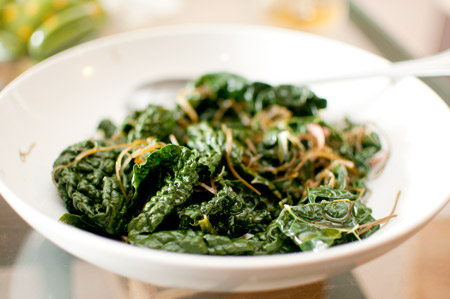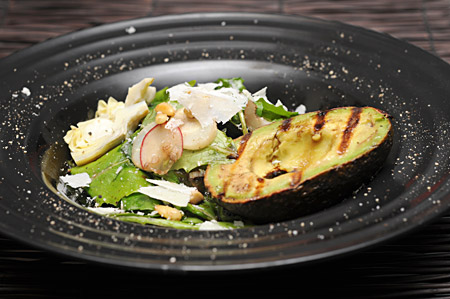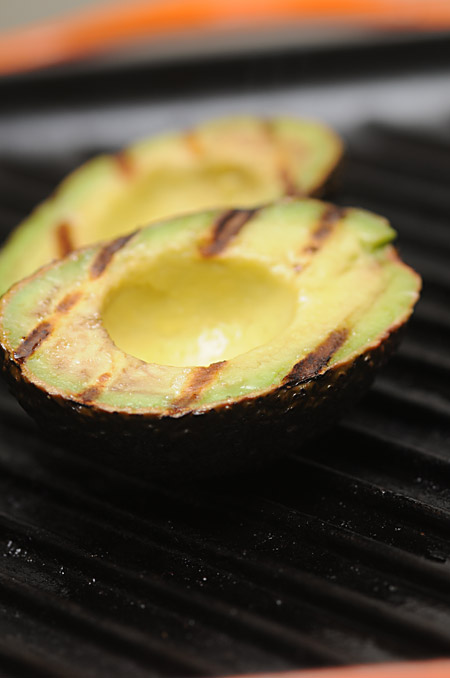Fennel is a wonderful, versatile aromatic vegetable that could be used in numerous dishes and utilizing many cooking methods. This vegetable is widely used in Italian, French and Mediterranean cooking. I have been experimenting with it for over a few years and keep stumbling on more innovative ways to cook it. From substituting onion with fennel (my wife is allergic to alum family, quite unfortunately), roasting meat on it or adding it to stews; fennel is great in many meals and will add new flavors to your culinary repertoire. There are 3 main parts of fennel: The white bulb, green stalks, and green dill-like herbs. There are also seeds of course, but they are to be bought separately as seeds.
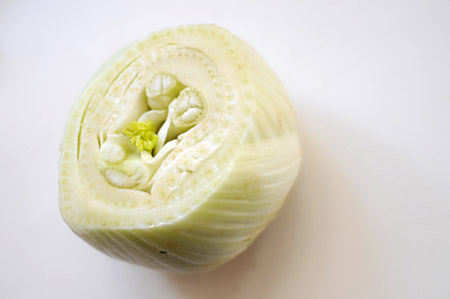
Fresh Fennel
Here are 12 basic ways to cook Fennel.
1. Grill it
Simple and straight forward! Cut it into ½ inch wide rounds (much like you would slice an onion), brush it with olive oil and toss it on your well heated grill, or griddle. Grill on each side about 5 minutes until dark golden ridges appear. Grilling fennel with give it sweet and smoky taste.
2. Sauté it
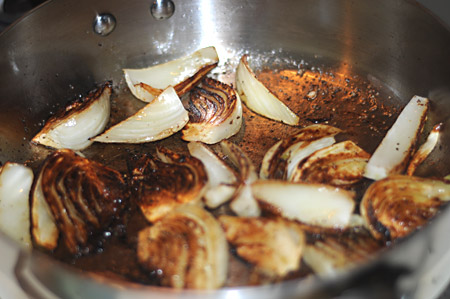
Sauted Fennel
Same thing as with grilling: cut into either ½ inch rounds, or cut vertically into four triangular shapes, then cut each triangle into half again and sauté until golden brown on each side and soft in a tablespoon of olive oil, or oil and butter mixed together. Add a pinch of salt and pepper or season with other fresh herbs to taste.
3. Add to Soups and Stews
I have been looking for a magic solution to getting around my wife’s allergy to onion for years now. The closest I came up with is using a mixture of fennel and green cabbage in soups and stews. It definitely adds great flavor, otherwise absent without onion and comes pretty damn close in texture as well.
Sauté fennel instead of, or with onion and mirepoux in the beginning of making your soup until soft (about 10 minutes) Use similarly in stews, or cut into thicker cubes and add to slow-cooking braises. Fennel is great in braises, as it will flavor wine while its simmering.
4. Add to Stocks
Here is where you can use these seemingly useless green stalks! I save those stalks (you can freeze them) for when I make broth, cut them up into cubes, much how you would treat celery and add them to variety of stocks I make. Add to stocks together with onions, carrots, celery.
5. Roast with other vegetables
Winter and fall roasts can benefit greatly from an addition of fennel. Simply cut into any shape (I usually quarter fennel for my roasts) add potatoes, turnips, carrots, beets, mushrooms, anything else you like roasting, coat with olive oil and your favorite herbs and roast in a Dutch oven or a roasting pan for 45 minutes in the oven at 375 degrees.
6. Use in salads
Great trick to add extra crunch to your salads: Slice very thin (yes that is the trick here), or use a mandolin for best results and add to any salad. I love the addition of fennel to this simple salad:
Simple fall salad:
Roasted beets, fresh arugula, shaved fennel & blue cheese.
7. Fennel Gratin
Much like Potato Au Gratin: slice into rounds or triangles, layer in buttered earthenware dish, coat with béchamel sauce (2 tbsp butter + 3 tbsp flour + 2 cups milk, simmered 20 –25 mins), or heavy cream and gruyere & parmesan cheese, a pinch of nutmeg and thyme, repeat the process to create more layers. Generously cover the top layer with cheese and bake for 45 minutes or until soft at 400 degrees. This is a great, traditional Italian dish, often used for Christmas.
8. Use in Sauces
I often infuse my sauces (béchamel or brown sauce for instance) by adding a quarter or a half of fennel pinned with a clove and a bay leaf (this is called piquet). Reduce your stocks with a half a bulb or a few stalks of fennel prior to thickening your sauce.
9. Use as an Aromatic vegetable (to roast meat, chicken, etc with)
Roast (lift up) your meat or chicken on a layer of aromatic vegetables (onions, fennel, carrots, potatoes etc) Then use the fat soaked vegetables as a side dish along the meat. Potatoes are not aromatic actually, but are great because they soak up fat very well.
10. Use in Risotto
Fennel is great in risotto! Sauté finely diced fennel in butter or oil prior to adding rice to the pan, then cook risotto as usual (adding liquid slowly to fat coated rice). I usually add sun-dried tomatoes and pine nuts with my fennel risotto (1 ½ cup rice), cooking it in light vegetable broth (4.5 cups) and a cup of white wine (1 cup).
11. Using Herbs in dips (alike dill)
Dice the hell out of green herbs that look much like dill and use to flavor sour cream, crème fraiche, cream sauces, butters, mayonnaise and other cream, egg or yogurt based dips.
12. Using seeds
Fennel seeds are especially flavorful. They could be used to add flavor to beans, stews, roasts, tagine dishes and Indian style dishes, like vegetables or cooked garbanzo beans (chickpeas). Usually you add seeds to hot oil until they start popping or turn lightly brown. Make sure not to burn seeds. Then you can add whatever else you might be cooking: onion, beans, vegetables, etc. This method infuses the oil. Whatever you choose to use seeds for need to cook for awhile, making seeds ideal for stewed or slow-roasted dishes.
